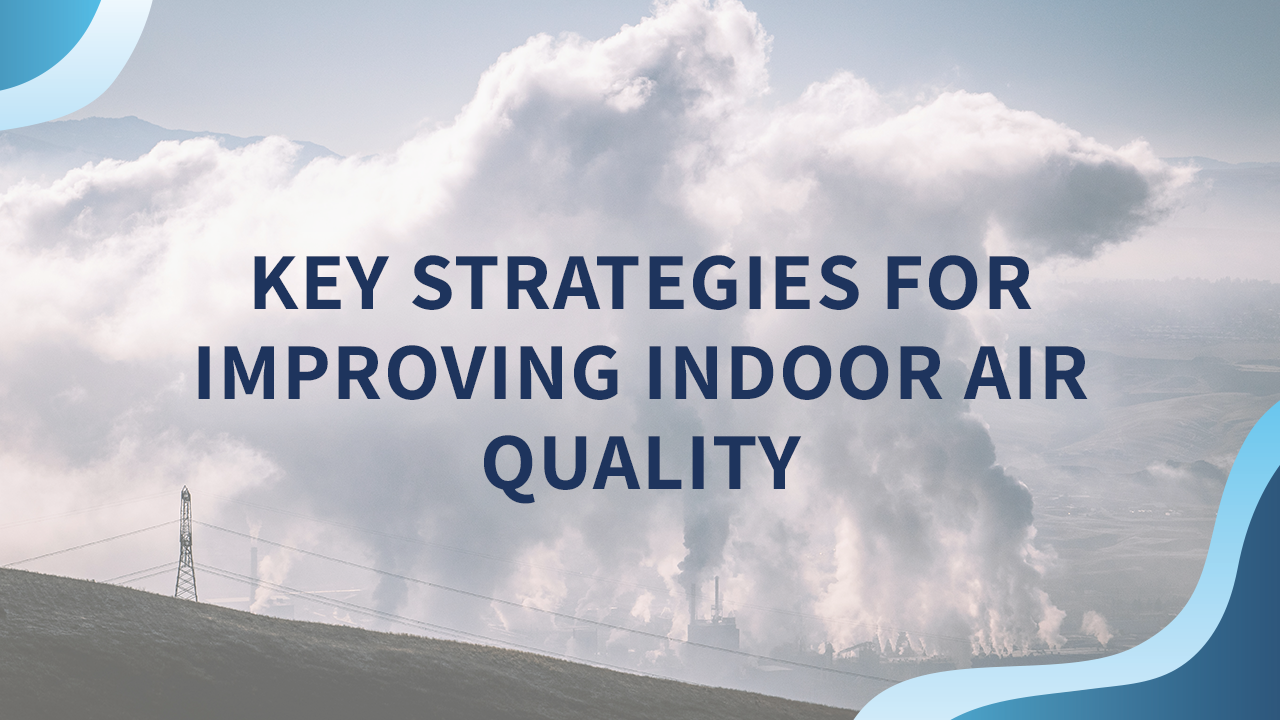When AirAdvice conducted an IAQ study for American homes, it found some alarming results. An astounding 96.7% of all homes had at least one of six common IAQ problems. This includes chemicals, allergens, temperature, humidity, carbon monoxide, and carbon dioxide.
Half of the homes contained three or more pollutants, while almost one in five exhibited four or more IAQ problems.


Importance of IAQ for Health
Indoor air quality in multifamily housing landed on the radar of consumers worldwide in 2020 due to an airborne virus that turned into a global pandemic. However, improving the IAQ in some buildings proved more challenging than others.
Apartment dwellers face obstacles to optimal IAQ conditions as they are most likely sharing air with fellow residents, even if quarantined in their homes. Likewise, since the virus travels via droplets that can remain airborne for minutes to hours, an infected person can cough or even breathe in a hallway or shared common areas and infect people without ever encountering them.
What Is Acceptable Indoor Air Quality?
Acceptable indoor air quality is based on indoor CO2 concentrations above 700 parts per million (ppm) above outdoor CO2 concentrations will satisfy a substantial majority (about 80%) of the occupants.
What If You Live In An Apartment?
Apartments can have the same indoor air problems as single-family dwellings because many sources of contamination, such as indoor building materials, furnishings, and household products, are similar. Such sources cause indoor air problems identical to those in offices, such as contaminated ventilation systems, poorly located outdoor air intakes, or maintenance activities.
Solutions to air quality problems in apartments, as in homes and offices, involve such actions as:
- Eliminating or controlling the sources of pollution
- Increasing ventilation
6 Ways to Improve
Fortunately, a variety of methods are available to improve indoor air quality in multi-family as well as the individual homes within them, including:
Boost Ventilation
Most multi-family residential buildings feature HVAC systems that do not mechanize outdoor air into the house. However, property owners and managers can improve IAQ for their residents by improving ventilation within multi-family housing communities. By inviting more outdoor air inside the building, the exchange lowers the concentration of indoor pollutants. It’s the same logic behind opening a window to let smoke escape a building. Multi-family building ventilation can be improved through additional fans in ceilings, bathrooms, and kitchens and mechanical methods such as integrating outdoor air intake into HVAC systems.
Seal as Many Air Leaks as Possible
Air will travel from one unit to another through any hole or passage it can find. Air sealing, however, helps reduce unwanted air movements within a building by eliminating those leaks. Sealing even tiny gaps and openings between apartments helps improve IAQ by reducing the odors, smoke, pathogens, and other pollutants that can travel from one home to the next. Common multi-family building areas susceptible to air leaks include the roof, windows, doors, pipes, and vents.
Monitor IAQ
Various intelligent appliances that can monitor and test IAQ have been recently introduced. These devices can monitor indoor pollutants ranging from radon to mold. In addition, many IAQ monitors utilize the Internet of Things and a building’s Wi-Fi signal to activate an accompanying air-cleaning device.


Install Air Cleaners
A variety of devices are available to clean indoor air. However, expensive whole-house systems are unlikely to be installed in most multi-family buildings. Residents can, however, use tabletop air cleaners to improve the IAQ within their specific homes. While every air cleaner model is unique in its efficacy based on factors such as the type of filter and the amount of air drawn into the device, most tabletop models are less effective and don’t remove gaseous pollutants.
Maintain Equipment
Preventative HVAC maintenance is vital to achieving optimal IAQ in a multi-family building. HVAC technicians can ensure entire systems, including vents, filters, and ductwork, are free of debris and pollutants. Frequently changing HVAC filters alone can vastly improve IAQ. Stronger filter grades, particularly high-efficiency particulate air (HEPA) filters, are an effective solution for many particulates in the air. Still, they should be changed monthly for the best results. Anti-bacterial filters can even remove pathogens like viruses from the air before it is re-circulated in a building.
Motili’s multi-family clients benefit from preventative maintenance programs that have been shown to boost resident satisfaction by double-digit percentages.
Manage Humidity Levels
Controlling the humidity in a home not only boosts comfort but can also reduce energy consumption and hinder the reproduction of pathogens. Although homes are thought to be most comfortable when the level of relative humidity falls between 30% and 50%, the lowest amount of contaminants is found in the air when the humidity is between 40% and 60%, according to Sterling, Arundel, and Sterling in their 1985 report. Although their information was published more than 35 years ago, most multi-family buildings around in 1985 have a similar design today.
Using humidifiers and dehumidifiers to maintain a relative humidity of about 50% is a good compromise. While humidity levels within entire multi-family buildings can be challenging to control, residents can use the devices in their homes.
6 Challenges in Multifamily Buildings for Ideal IAQ
Awareness is half the battle, and indoor air pollutants can hardly be controlled if they aren’t identified. To determine the best strategies to improve IAQ in a multi-family community, property managers and residents must establish what IAQ issues they are facing. Is it a simple matter of humidity, temperature, or ventilation control? Are more severe contaminants such as carbon monoxide or mold present? Are more residents getting sick, or is smoking allowed in the building?
Air Moves Between Apartments
A variety of factors influence air movement in a building. For example, indoor conditions like temperature, humidity, and building design, and outside factors like wind velocity, direction, and outdoor temperatures. Inside a building, air naturally moves from higher-pressure areas to lower-pressure areas through any hole or passage, carrying humidity, dust, and pathogens. Therefore, buildings lacking proper seals are at risk of air moving directly from one apartment to another.
Polluted Outdoor Air Isn’t Fresh
People commonly open windows to “let in fresh air” when their IAQ becomes problematic. However, what happens when the outdoor air is more polluted than the indoor air? As many multi-family buildings are found in urban areas, they naturally face a greater risk of outside air pollution. When apartment dwellers open their windows, they invite even worse air into their homes.
Older Buildings Weren’t Designed With IAQ In Mind
Multi-family buildings usually weren’t designed for controlled IAQ until 1973 when the American Society of Heating Refrigerating and Air-Conditioning Engineers first published ventilation standards with IAQ in mind. As a result, most multi-family buildings in large urban centers like New York and Chicago were constructed before 1973. On the other hand, newly constructed multi-family properties are generally designed with ventilation systems that control the exchange of indoor and outdoor air and the movement of indoor air.
Open Windows Increase Energy Consumption
The outdoor air is fairly free of pollutants. In that case, apartment residents might improve their IAQ by opening windows, allowing any polluted or stagnant indoor air to escape the dwelling. While this might be an effective strategy in some places, it also serves as a double-edged sword since opening windows often increases the energy an HVAC system needs to control the indoor climate properly.
Humidity Is Difficult To Control In Many Multi-Family Buildings
Controlling indoor humidity levels more effectively limits the spread of pathogens like COVID-19 than any outdoor air solution. Unfortunately, moisture levels can only be managed effectively in buildings with central air handling systems that humidify and dehumidify the air. Unfortunately, most multi-family buildings lack these features, putting apartment dwellers at greater risk of viral exposure in the winter when outdoor humidity levels are cold and dry. Residents can, however, utilize personal devices to try and control humidity levels in their units.
Multi-Family Buildings Can Be A Haven For Indoor Pollutants
Understanding and identifying common pollutants will help establish an effective IAQ strategy for a multi-family building. Other residents aren’t the only source of indoor air pollution in multi-family housing. Sources like old asbestos, gas-powered appliances, paint, and cleaning products can negatively affect the IAQ in a multi-family building. Other indoor pollutants in multi-family housing include pesticides, smoke, furnishings, and even air fresheners.
Motili HVAC Multi-Family Technology Solutions
Motili’s platform is one of the latest innovative solutions that allows property owners and managers to efficiently manage HVAC multi-family technology projects for multiple property types like apartment communities and commercial buildings.
Sustainability, automation, and data management are core values upheld throughout the HVAC process.
The Motili solution includes a web platform that provides detailed work status and reporting, automated scheduling and contractor dispatching, text and email notifications, and a mobile app for contractors. It can easily integrate with existing client systems. Our finely-tuned process boosts efficiency, reduces cost, and can ultimately improve customer satisfaction.
Motili’s cutting-edge technology will help property owners manage their HVAC and hot water systems through technology, proactive and reactive repair, and replacement projects.
The experts at Motili possess the knowledge and tools to properly guide you through all types of HVAC projects.


HVAC Technology & Motili HVAC Solutions
It’s simple for facility managers to connect with contractors when they use Motili, and HVAC contractors no longer need to scramble to find steady work year-round. As a result, it’s now easier than ever to grow an HVAC contractor business with the Motili app.
Technology allows HVAC contractors to accept jobs from the app and clear communication with details about new jobs, service calls, and work orders. In addition, contractors using the Motili app can view and accept jobs as they become available for ongoing, consistent work. Since Motili averages more than 50,000 new system installs and more than 90,000 service work orders each year, there is plenty of work to go around.
How does it work?
Motili notifies contractors when a client needs service. Contractors choose which jobs to accept, but there’s no competition with other contractors once a position is taken. Motili provides the equipment, saving the contractor time and energy.












